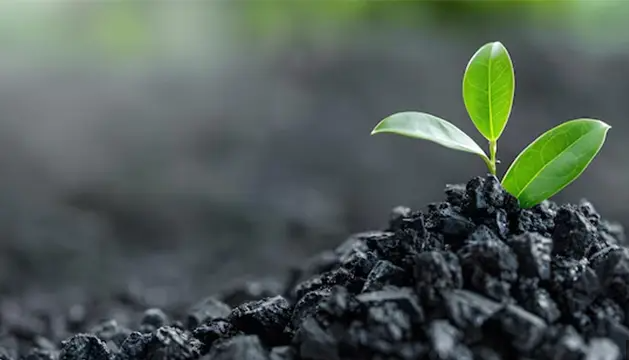Biochar is a product created through the pyrolysis of organic materials in an anaerobic or oxygen-deficient environment at temperatures between 400-450 degrees Celsius. This process is known as pyrolysis.
Biochar has the ability to persist stably in soil and increase the amount of carbon stored in the soil, reducing carbon emissions into the atmosphere and positively impacting soil productivity.

II. Properties of Biochar
Biochar, a porous material, helps retain water and nutrients in the soil for plants to absorb as they grow.
-
Adsorption properties: Biochar can fix heavy metals, pesticides, herbicides, and hormones; prevent the leaching of nitrates and harmful bacteria into river systems; and reduce N2O and CH4 emissions from the soil.
-
Physical properties: Biochar is black, highly porous, lightweight, fine-grained, and has a large surface area. Thanks to these properties, biochar helps increase microbial activity, retain water and nutrients in the soil. Consequently, it often allows for reduced use of fertilizers and chemicals, improving soil quality and increasing crop yields.
III. Benefits of Biochar
Improving soil quality
-
Increases soil aeration, water retention, and nutrient-holding capacity.
-
Improves soil structure, creating favorable conditions for root development.
-
Enhances the activity of beneficial microorganisms in the soil.
Mitigating climate change
-
Biochar acts as a natural carbon sink, helping to reduce CO2 emissions into the atmosphere.
Enhancing crop productivity
Crops grown on soil amended with biochar often yield higher, have better quality, and are more disease-resistant.
Diverse applications
-
Wastewater treatment: Ability to absorb pollutants in water.
-
Construction materials: Creating environmentally friendly building materials.
-
Bioenergy production: Producing biogas.
IV. Scope of application
- In agriculture: Biochar is used to increase crop yields and improve soil. According to the United Nations Industrial Development Organization (UNIDO), biochar can retain carbon content in the soil for up to hundreds of years. Just 1 gram of biochar can be used to improve 120 square meters of land. It has the ability to retain moisture in the soil and help absorb nutrients. Biochar can also stabilize soil pH and improve soil drainage. Additionally, it is used to improve the quality of red soil and saline soil, especially in rural areas and barren lands.
- In waste treatment: Biochar is used to treat organic waste such as sludge and organic waste. Biochar can absorb toxic substances in waste and reduce their dispersion into the environment.
- In renewable energy production: Biochar can be used to create biofuels and burned to produce energy. Using biochar as a clean fuel source can help reduce greenhouse gas emissions and contribute to reducing dependence on fossil fuels.
V. Biochar production methods
There are many ways to create biochar, all of which generally involve heating biomass with little or no oxygen to remove volatile gases, leaving behind carbon. This simple process is called pyrolysis, often from the processes of pyrolysis or gasification. These methods can produce clean energy in the form of hot gas or tar & wood vinegar along with biochar. These energy sources can be recovered for other purposes or simply burned and released as heat.
VI. Biochar production technologies
-
Pyrolysis systems: Pyrolysis systems use furnaces, retorts, and other specialized equipment to contain biomass and thermally decompose it under oxygen-deficient conditions. The reactor is vented to allow the pyrolysis gas (syngas) to escape. Pyrogas is often referred to as "syngas or synthesis gas". This process becomes self-sustaining when the syngas produced is burned and heat is released. There are currently two types of pyrolysis systems in use: fast pyrolysis and slow pyrolysis. Fast pyrolysis tends to produce more tar and wood vinegar while slow pyrolysis produces more syngas.
-
Gasification systems: Gasification systems produce smaller amounts of biochar in a reactor that is heated directly with incoming air. The more oxygen the production unit removes, the more biochar can be produced. Biochar production is optimized under oxygen-free conditions.
Contact
GIANT BARB SCIENCE AND ENVIRONMENT JOINT STOCK COMPANY
📞 Hotline: +84 995 206 666
✉️ Email: info@giantbarb.com
🏢 Headquarter: No.07 Ton That Thuyet, Dich Vong Hau ward, Cau Giay district, Hanoi